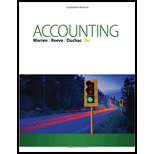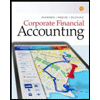
Concept explainers
Under U.S. GAAP, LIFO is an acceptable inventory method. Financial statement information for three companies that use LIFO follows. All table numbers are in millions of dollars.

Assume these companies adopted IFRS, and thus were required to use FIFO, rather than LIFO.
a. Prepare a table with the following columns:

(1) Difference between FIFO and LIFO
(2) Revised IFRS net income using FIFO.
(3) Difference between FIFO and LIFO inventory valuation as a percent of total current assets.
(4) Revised IFRS net income as a percent of the reported net income.
b. Complete the table for the three companies.
c. For which company would a change to IFRS for inventory valuation have the largest percentage impact on total current assets (Col. 3)?
d. For which company would a change to IFRS for inventory valuation have the largest percentage impact on net income (Col. 4)?
e. Why might Kroger have a negative impact on net income from using LIFO, while the other two companies have a positive impact on net income from using LIFO?
(a)
International Financial Reporting Standards (IFRS): IFRS are a set of international accounting standards which are framed, approved, and published by International Accounting Standards Board (IASB) for the preparation and disclosure of international financial reports.
Generally Accepted Accounting Principles (GAAP): These are the guidelines necessary to create accounting principles for the implementation of financial information reporting in the Country U.
First-in-First-Out(FIFO): In this method, items purchased initially are sold first. So, the value of the ending inventory consists the recent cost for the remaining unsold items.
Last-in-First-Out(LIFO): In this method, items purchased recently are sold first. So, the value of the ending inventory consists the initial cost for the remaining unsold items.
To draft: A table with the columns given in the problem
Explanation of Solution
Table is prepared as follows (amounts in millions of dollars):
| FIFO less LIFO | IFRS Net Income | |||
| Company E | ||||
| Company K | ||||
| Company F |
Table (1)
(b)
To complete: The table prepared in Part (a)
Explanation of Solution
Complete the table as follows (amounts in millions of dollars):
| FIFO less LIFO | IFRS Net Income | |||
| Company E | $21,348 | $30,143 | ||
| Company K | 827 | 1,173 | ||
| Company F | 865 | 4,686 |
Table (2)
Working Notes:
Compute FIFO less LIFO (amounts in millions of dollars).
| FIFO | LIFO | FIFO less LIFO | |
| Company E | $31,200 | $9,852 | $21,348 |
| Company K | 5,793 | 4,966 | 827 |
| Company F | 6,782 | 5,917 | 865 |
Table (3)
Deduct the LIFO value from FIFO value to get FIFO less LIFO.
Compute IFRS net income (amounts in millions of dollars).
| Net Income as Reported | Impact on Net Income From Using LIFO Rather Than FIFO | IFRS Net Income | |
| Company E | $30,460 | $317 | $30,143 |
| Company K | 1,116 | (57) | 1,173 |
| Company F | 4,690 | 4 | 4,686 |
Table (4)
Deduct the impact on net income value from net income reported value to get IFRS net income.
Compute FIFO less LIFO divided by total current assets (amounts in millions of dollars).
| FIFO less LIFO | Total Current Assets | ||
| Company E | $21,348 | $58,984 | 36% |
| Company K | 827 | 7,621 | 11% |
| Company F | 865 | 34,368 | 3% |
Table (5)
Divide FIFO less LIFO value by total current assets value to get the value in last column. Refer to Table (3) for value and computation of FIFO less LIFO value.
Compute IFRS net come divided by reported net income(amounts in millions of dollars).
| IFRS Net Income | Net Income as Reported | ||
| Company E | $30,143 | $30,460 | 99% |
| Company K | 1,173 | 1,116 | 105% |
| Company F | 4,686 | 4,690 | 100% |
Table (6)
Divide IFRS net income value by reported net income value to get the value in last column. Refer to Table (4) for value and computation of IFRS net income value.
(c)
To indicate: The company which would have the highest impact on total current assets due to change in inventory valuation method, if the company uses IFRS instead of GAAP
Answer to Problem 3IFRS
If the inventory valuation method is changed to reflect the use of IFRS, Company E would have greatest impact on total current assets.
Explanation of Solution
Refer to Table (5) for value and computation of impact of change in inventory valuation method on total current assets.
(d)
To indicate: The company which would have the highest impact on net income due to change in inventory valuation method, if the company uses IFRS instead of GAAP
Answer to Problem 3IFRS
If the inventory valuation method is changed to reflect the use of IFRS, Company K would have greatest impact on net income.
Explanation of Solution
Refer to Table (6) for value and computation of impact of change in inventory valuation method on net income.
(e)
To discuss: The reasons for negative impact on net income if LIFO is used rather than FIFO
Explanation of Solution
During inflation, the inventory purchased last will have higher price than the inventory purchased first. Thus, under LIFO method, the inventory purchased last with higher price will be sold first, thereby increasing the cost of goods sold. Increase in cost of goods sold decreases the net income.
Want to see more full solutions like this?
Chapter 15FSI Solutions
ACCOUNTING-W/CENGAGENOWV2 ACCESS
- Can you explain this general accounting question using accurate calculation methods?arrow_forwardI need help finding the accurate solution to this general accounting problem with valid methods.arrow_forwardI am looking for help with this general accounting question using proper accounting standards.arrow_forward
 Intermediate Accounting: Reporting And AnalysisAccountingISBN:9781337788281Author:James M. Wahlen, Jefferson P. Jones, Donald PagachPublisher:Cengage Learning
Intermediate Accounting: Reporting And AnalysisAccountingISBN:9781337788281Author:James M. Wahlen, Jefferson P. Jones, Donald PagachPublisher:Cengage Learning Cornerstones of Financial AccountingAccountingISBN:9781337690881Author:Jay Rich, Jeff JonesPublisher:Cengage LearningPrinciples of Accounting Volume 1AccountingISBN:9781947172685Author:OpenStaxPublisher:OpenStax College
Cornerstones of Financial AccountingAccountingISBN:9781337690881Author:Jay Rich, Jeff JonesPublisher:Cengage LearningPrinciples of Accounting Volume 1AccountingISBN:9781947172685Author:OpenStaxPublisher:OpenStax College Financial Reporting, Financial Statement Analysis...FinanceISBN:9781285190907Author:James M. Wahlen, Stephen P. Baginski, Mark BradshawPublisher:Cengage Learning
Financial Reporting, Financial Statement Analysis...FinanceISBN:9781285190907Author:James M. Wahlen, Stephen P. Baginski, Mark BradshawPublisher:Cengage Learning Corporate Financial AccountingAccountingISBN:9781305653535Author:Carl Warren, James M. Reeve, Jonathan DuchacPublisher:Cengage Learning
Corporate Financial AccountingAccountingISBN:9781305653535Author:Carl Warren, James M. Reeve, Jonathan DuchacPublisher:Cengage Learning Accounting (Text Only)AccountingISBN:9781285743615Author:Carl Warren, James M. Reeve, Jonathan DuchacPublisher:Cengage Learning
Accounting (Text Only)AccountingISBN:9781285743615Author:Carl Warren, James M. Reeve, Jonathan DuchacPublisher:Cengage Learning





